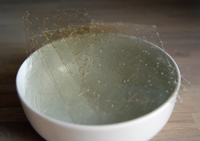
Photo from wikipedia
In this study, the molecular mobility of fish flesh was measured by low field nuclear magnetic resonance (LF-NMR) relaxation. Sardine, tuna and mackerel were frozen at −40 °C and stored for… Click to show full abstract
In this study, the molecular mobility of fish flesh was measured by low field nuclear magnetic resonance (LF-NMR) relaxation. Sardine, tuna and mackerel were frozen at −40 °C and stored for 1 day (24 h); and then these samples were thawed at room temperature (20 °C). The relaxation of water protons in fish flesh was measured for fresh (i.e., before freezing) and multi-cycle freeze–thaw samples (i.e., up to 12 times). Three domains from different pools of protons (i.e., low-mobile, medium-mobile and high-mobile) were identified from the relaxation curve. The T2b (low-mobile), T21 (medium-mobile) and T22 (high-mobile) indicated the proton populations in the protein molecules, strongly bound water molecules, and weakly bound water molecules, respectively. In all cases, the relaxation time (T2b: sardine r = 0.736 and p < 0.01, tuna r = 0.857 and p < 0.001, mackerel r = 0.904 and p < 0.001; and T22: sardine r = 0.956 and p < 0.0001, tuna r = 0.927 and p < 0.0001, mackerel r = 0.890 and p < 0.0001) increased with the freeze–thaw cycles and it reached a nearly constant value after 6 freeze–thaw cycles. The increased relaxation time (i.e., higher mobility) up to 6 freeze–thaw cycles could be due to the increase in proton mobility. However, relaxation time (T21: sardine r = −0.510 and p > 0.05, tuna r = 0.162 and p > 0.5, mackerel r = 0.513 and p > 0.01) showed insignificant change with the increase of freeze–thaw cycles, which indicated minimal change in the medium-mobile protons. The results in this study revealed that the changes in proton mobility in the fish flesh during freeze–thaw cycles could be identified using T2b and T22 relaxation of LF-NMR.
Journal Title: Fisheries Science
Year Published: 2017
Link to full text (if available)
Share on Social Media: Sign Up to like & get
recommendations!